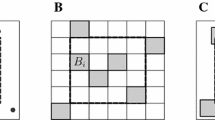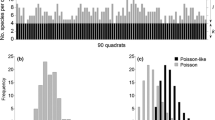Summary
A method for the analysis of spatial pattern using quadrats of different sizes is developed on the basis of the relationship of mean crowding (\(\mathop m\limits^* \)) to mean density (m). The\(\mathop m\limits^* \)-on-m regression obtained by successive changes in quadrat size in a single population (unit-size relation) shows a characteristic pattern according to the type of distribution. By aid of the ρ-index proposed here, we can distinguish the random, aggregated and uniform distributions of the basic components (individual or group of individuals). The ρ serves as an index of spatial correlation between neighbouring quadrats, and it also provides information on the approximate area occupied by clump (colony), distribution pattern of individuals within clumps, and possibly the distribution pattern of clumps themselves.
Even in a specified type of distribution, the unit-size\(\mathop m\limits^* - m\) relation is not necessarily identical with the\(\mathop m\limits^* - m\) relation for a series of populations at a particular quadrat size (series relation). The changes in the series\(\mathop m\limits^* - m\) relationship with successive changes of quadrat sizes are also considered for some basic patterns of distributions. The combined use of the unit-size and the series\(\mathop m\limits^* - m\) relations for a set of populations of the species under study may provide a satisfactory picture of the spatial pattern characteristic of the species.
Application of the method is illustrated by using distribution data of several species of animals and plants. The advantage of the present method over other methods are discussed, and the formulae for determining the optimum quadrat unit in sampling surveys are given.
Similar content being viewed by others
References
Anderson, D. J. (1971) Spatial patterns in some Australian dryland plant communities. InStatistical ecology, Vol. 1 (ed. byG. P. Patil et al.), pp. 271–286. Penn. State Univ. Press, University Park and London.
Bartlett, M. S. (1971) Two-dimensional nearest-neighbor systems and their ecological applications. InStatistical ecology, Vol. 1 (ed. byG. P. Patil et al.), pp. 179–194. Penn. State Univ. Press, University Park and London.
Burrage, R. H. andG. G. Gyrisco (1954) Distribution of third instar larvae of the European chafer and the efficiency of various sampling units for estimating their populations.J. econ. Ent. 47: 1009–1014.
Cain, S. A. andF. C. Evans (1952) The distribution patterns of three plant species in an old-field community in Southeastern Michigan.Contr. Lab. Vertebr. Biol., Uuiv. Michigan, No. 52: 1–15.
Evans, F. C. (1952) The influence of size of quadrat on the distribution patterns of plant populations.Contr. Lab. Vertebr. Biol., Univ. Michigan, No. 54: 1–10.
Gérard, G. andP. Berthet (1971) Sampling strategy in censusing patchy populations. InStatistical ecology, Vol. 1 (ed. byG. P. Patil et al.), pp. 59–67. Penn. State Univ. Press, University Park and London.
Greig-Smith, P. (1952) The use of random and contiguous quadrats in the study of the structure of plant communities.Ann. Bot., New Ser. (Lond.),16: 293–316.
Greig-Smith, P. (1964)Quantitative plant ecology. 2nd ed. Butterworths, London.
Iwao, S. (1968) A new regression method for analyzing the aggregation pattern of animal populations.Res. Popul. Ecol. 10: 1–20.
Iwao, S. andE. Kuno (1968) Use of the regression of mean crowding on mean density for estimating sample size and the transformation of data for the analysis of variance.Res. Popul. Ecol. 10:210–214.
Iwao, S. andE. Kuno (1971) An approach to the analysis of aggregation pattern in biological populations. InStatistical ecology, Vol. 1 (ed. byG. P. Patil et al.), pp. 461–513. Penn. State Univ. Press, University Park and London.
Kershaw, K. A. (1964)Quantitative and dynamic ecology. Edward Arnold, London.
Kojima, K. andM. Okamoto (1957) Distribution pattern of the paddy borer, the rice stem borer and the purplish stem borer in the paddy field.Res. Rept. Kôchi Univ. 6(29): 1–6. (In Japanese with English summary)
Kono, T. (1958) Spatial distribution of the rice stem borer in paddy fields.Plant Protec. (Tokyo),12: 252–254. (In Japanese)
Miyamoto, Y. (1951) Observation on the dispersion of the rice-borer larvae.Botyu-Kagaku,16: 40–45. (In Japanese with English summary)
Morisita, M. (1959) Measuring of the dispersion of individuals and analysis of the distributional patterns.Mem. Fac. Sci, Kyushu Univ., Ser. E, (Biol.),2: 215–235.
Morisita, M. (1964) Application ofI δ-index to sampling techniquesRes. Popul. Ecol. 6: 43–53.
Morisita, M. (1971) Composition of theI δ-index.Res. Popul. Ecol. 13: 1–27.
Nakamura, H. (1968) A comparative study on the oviposition behavior of two species ofCallosobruchus (Coleoptera: Bruchidae).Jap. J. Ecol. 18: 192–197. (In Japanese with English summary)
Neyman, J. (1939) On a new class of ‘contagious’ distributions, applicable in entomology and bacteriology.Ann. Math. Stat. 10: 35–57.
Ôtake, A. (1961) Sampling techniques applicable to studies on rice-stem borer egg-mass populations.Bull. Shimane Agric. Coll. 9, A-1: 209–221.
Phillips, M. E. (1954) Studies in the quantitative morphology and ecology ofEriophorum angustifolium Roth. II. Competition and dispersion.J. Ecol. 42: 187–210.
Pielou, E. C. (1969)An introduction to mathematical ecology. Wiley & Sons, New York.
Thompson, H. R. (1958) The statistical study of plant distribution pattern using a grid of quadrats.Austr. J. Bot. 6: 322–342.
Author information
Authors and Affiliations
Additional information
Contributions from JIBP-PT, No. 151.
Rights and permissions
About this article
Cite this article
Iwao, S. Application of the\(\mathop m\limits^* - m\) method to the analysis of spatial patterns by changing the quadrat sizemethod to the analysis of spatial patterns by changing the quadrat size. Res Popul Ecol 14, 97–128 (1972). https://doi.org/10.1007/BF02511188
Issue Date:
DOI: https://doi.org/10.1007/BF02511188




